Viewpoints
Overview
‘Views’ in previous versions of the Sisense Infusion Apps have been replaced by 'Viewpoints'.
Viewpoints are tabular data structures that are created and configured in Sisense.
Viewpoints are shared with end-users, allowing them to interact with Sisense data in one or more Infusion Apps.
Users are able to work with Sisense data adjacently in the tools that they use everyday, while still benefiting from the analytical capabilities and data security rules applied to the data in Sisense.
Viewpoints are a more scalable and reliable solution than (legacy) Views.
Viewpoints are generally built around a specific use case, or the needs of a business department or user group. Attempting to cater to every micro-perspective can be counter-productive. It is recommended to:
- Utilize user permissions and data security rules to ensure the correct data and Viewpoints are seen by the correct users.
- As a rule of thumb, you should have no more than 3-4 Viewpoints per Business Area.
- Typically, 1 global Viewpoint and 2-3 high level stateful perspectives
Viewpoint Management
Click the Viewpoints icon ![]() at the top-right of any screen in the application to access Viewpoints via the Viewpoint Management page.
at the top-right of any screen in the application to access Viewpoints via the Viewpoint Management page.
The icon will be visible if:
-
Infusion Apps is active on the Sisense license, and
-
Infusion Services are toggled on via Admin > Infusion Management
See Enabling Infusion Apps for more information.
Note:
If you do not see this icon, contact your CSM to ensure the license settings are correct.
Any logged-in user with at least the role of Dashboard Designer has access to Viewpoint Management. Unlike Dashboards, Viewpoints do not have the concept of an owner, but instead have a creator. This means that all Viewpoints are visible, and editable, by any user with access to Viewpoint Management.

Viewpoints are displayed in a list. This list can be:
- Searched using the Viewpoint Name or Description which will filter the list
- Filtered and sorted by columns
|
Column |
Description |
Behavior |
|---|---|---|
|
Search |
Search field that can be used to filter the list of Viewpoints in the table. |
Search by |
|
Name |
The name that end users will see in Infusion Apps, and will reference when writing natural language queries. |
Sort (A-Z) Filter by Values |
|
Description |
The description that end users will see in their Infusion Apps next to the View Name. |
Sort (A-Z) Filter by Values |
|
Status |
The Viewpoint’s current status. |
Sort (A-Z) Filter by Values |
|
Third-Party Apps |
The Infusion Apps that the Viewpoint is shared with. |
None |
|
Last Published |
The date that the Viewpoint was last published with changes. |
Sort (A-Z) |
Note:
Previously created “Views” are not backwards compatible, and will not be displayed in this list.
Creating a Viewpoint
A Viewpoint can be created by any user who has at least the role of Dashboard Designer.
Viewpoints are supported in multi-tenant deployments. To create a Viewpoint in a tenant, the Viewpoint Creator must be logged into the specific tenant.
Note:
If Viewpoints need to be created across tenants, it is recommended to leverage the Infusion APIs as opposed to manually logging in to each tenant to create Viewpoints.
To create a Viewpoint:
-
Open the Viewpoint Management page.
-
Click + Viewpoint.
-
Give your Viewpoint a unique name (required). Special characters are not supported.
-
Give your Viewpoint a description (required).
-
Click Create.
Once created, a Viewpoint is visible on the Viewpoint Management page by any user who has access.
Viewpoints are exposed to users exactly as they are defined, so name each Viewpoint as descriptively as possible:
-
Keep names short and concise
-
Provide a meaningful description
However, you are able to change a Viewpoint’s name and description after creation.
Adding Data to a Viewpoint
Viewpoints contain data that is exposed to the end-user in an Infusion App. Viewpoints can be created using data from any of the following:
-
Live Models
-
ElastiCubes
-
Perspectives
Either search or click the drop-down list to view models and perspectives that are available to you.
Viewpoints will respect Data Model and Perspectives access rules. Depending on the user, a Viewpoint Creator:
-
may not see a particular data model or perspective
-
may not see all the tables or fields within the selected data model or perspective
Once selected, the tables and fields appear as collapsed rows. Expand each row to see the fields in each table. You can select as many fields as you want to include in your Viewpoint, but must include at least one field.
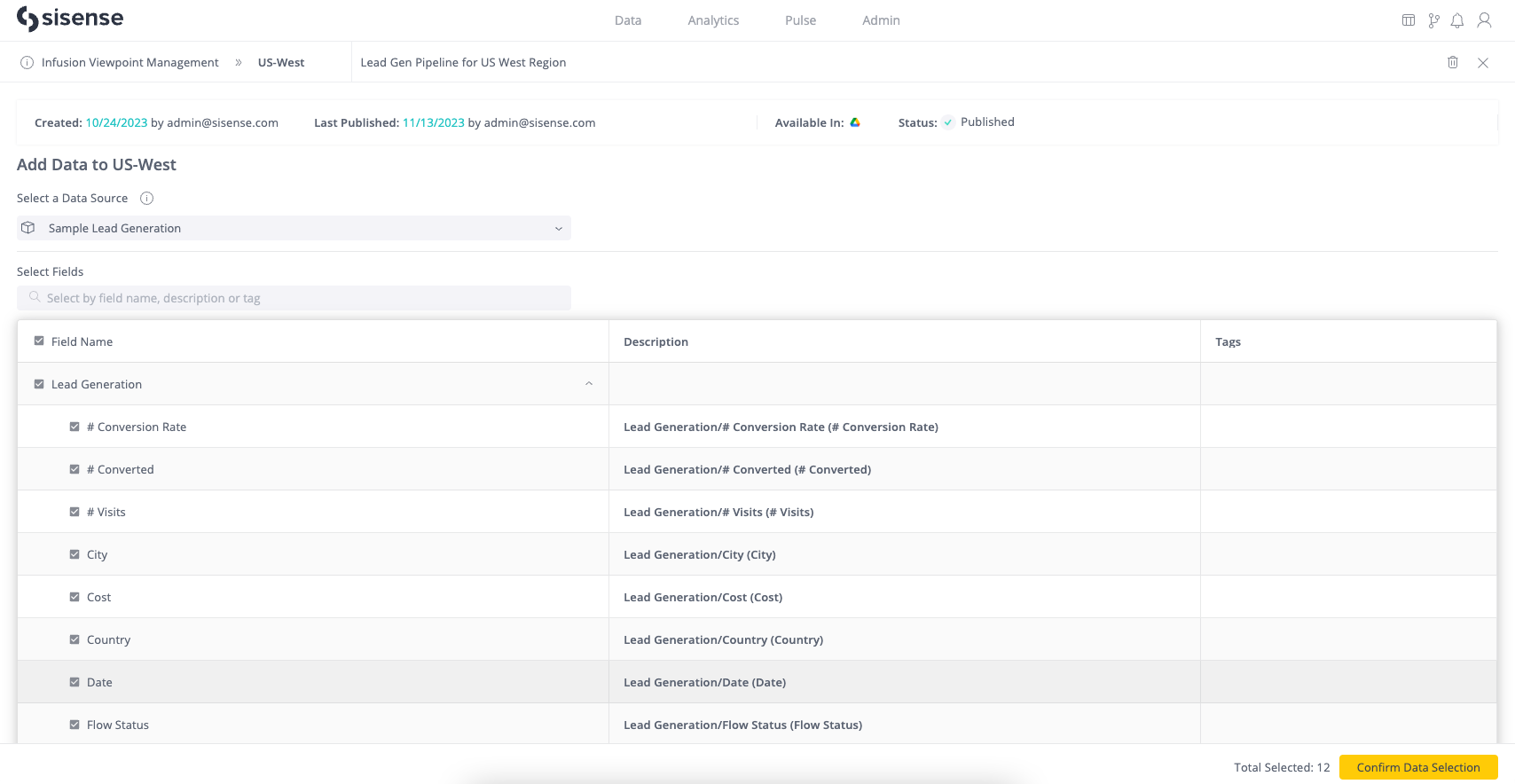
You can explore the data available in two ways:
-
Scroll while expanding and collapsing the rows to view the fields contained in each table
-
Search by field name, description, or tag
|
Column |
Description |
|---|---|
|
Field Name |
Field Name is displayed directly from the Data Model or Perspective. Fields are nested under a parent row displaying the name of the table the field can be found in. |
|
Description |
Descriptions are referenced from the data model, and may not appear if descriptions and/or tags have not been added by a Data Admin or Data Designer. |
|
Tag |
Tags are generated from the data model, and are displayed if available. |
Select an individual field, or select a table, which will select all fields contained within it. Once you complete your data selection, click Confirm Data Selection.
When selecting tables and fields to include in a Viewpoint, consider the use case and people that the Viewpoint is being created for.
When querying or downloading a Viewpoint in an Infusion App, any data security rules applied to the tables or rows are respected. If data security rules are applied, and apply to the user the Viewpoint is shared with, the user may only see a subset of the data.
Viewpoint Details
The Viewpoint Details page serves as the overview for the Viewpoint, after data has been selected. Within Viewpoint Details, you are able to configure data to customize how it is displayed to end users.
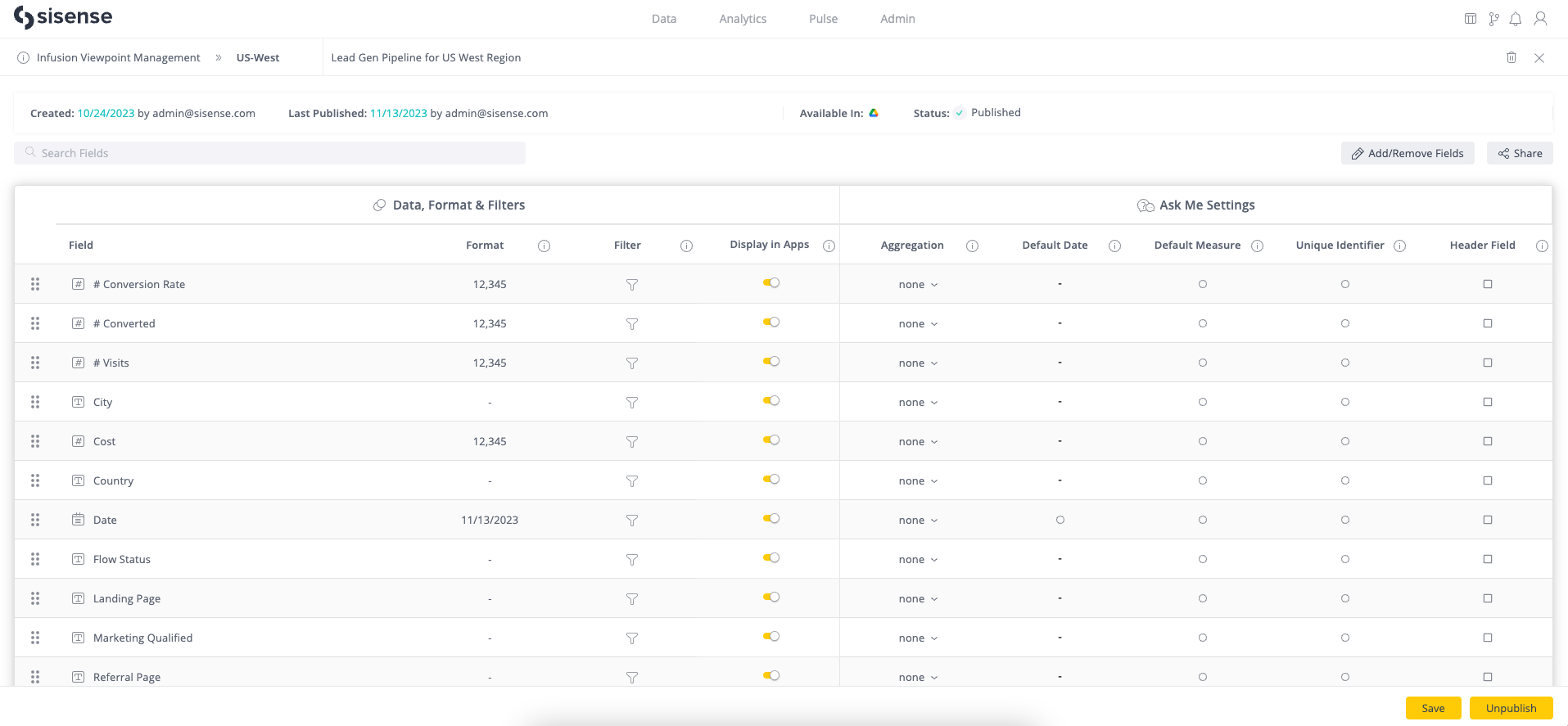
Each Viewpoint Details page has a header with information specific to that Viewpoint.
|
Header |
Description |
Behavior |
|---|---|---|
|
Name |
The name that users see and reference in their queries. |
Hover over and click inside the field to edit the description. |
|
Description |
The description that users see. |
Hover over and click inside the field to edit the name. Click outside of the field to save the new value. |
|
Created |
The date that the Viewpoint was initially created. |
Read-only. |
|
Last Published |
The date that the Viewpoint was last published with changes. |
Updates on publishing or republishing a Viewpoint. |
|
Available In |
The Infusion Apps that the Viewpoint is shared with. |
Updates on publishing or republishing a Viewpoint if the sharing permissions are changed. |
|
Status |
The Viewpoint’s current status. |
Updates based on user action of creation, publish, or unpublish. |
Note:
Changing the name of the View affects all Bookmarks which reference that View.
Data, Format, and Filters
In order to make Viewpoints more contextual and useful to Infusion App Users, they can use the Format & Filters section to:
- Reorder columns
- The order of the columns top to bottom will display left to right
- Rename columns
- Apply formatting
- Define filter conditions
|
Configuration |
Description |
Behavior |
|---|---|---|
|
Field |
The name of the field as defined in the data source table. |
Click the field cell to rename the field. Renamed fields will appear in the Viewpoint output. |
|
Format |
Displays the format of the data as defined in the data source table. |
Click the cell to apply formatting. Formatting can only be applied to fields with numeric values. |
|
Filter |
Applies filter parameters to the column data. |
Adding a filter to a field will result in a filtered dataset when users download or query a Viewpoint. When a filter is applied, the filter icon will change state. |
|
Display In App |
Enables or disables the filter. |
When Display in Apps is toggled off, the filter(s) will not display in Slack or Teams and cannot be used for additional filtering criteria. |
|
When Display in Apps is toggled on, the filter(s) will display in Slack or Teams and can be used for additional filtering criteria in all Infusion Apps. |
Note:
It is recommended to leverage the native, more robust, formatting options in Google Sheets or Office 365 (Excel). After the first download, each user can apply formatting using the native options. When the Viewpoints are refreshed, the formatting will be maintained.
Ask Me Settings
Viewpoints that are intended to be used in Slack or Teams have an additional set of configurations. These configurations are optional, but can help create a better experience for Infusion Chatbot Users.
|
Configuration |
Description |
Behavior |
|---|---|---|
|
Aggregation |
Sets the aggregation that is applied when a summary analysis is generated. Supported aggregations: Count, Sum, and Average. |
When results are displayed, selected aggregations will be applied to the fields in the Summary. This can only be used with numeric fields that are displayed at the record level. |
|
Default Date |
Set a field as the Default Date to be used when a query specifies a date range without a specific date field. Only date fields can be selected as a Default Date. A Viewpoint can have a maximum of one Default Date. |
When results are displayed, if no exact date has been specified, the default date will be used. |
|
Default Measure |
Set a field as the Default Measure when it needs to have more prominence in the results or during analysis. Any field can be set as the Default Measure, but it is recommended to select a field that contains quantitative values that you can measure. A Viewpoint can have a maximum of one Default Measure. |
When results are displayed, the default measure is chosen automatically in the top 10 chart. The default measure gets more analysis when using the Summary feature. |
|
Unique Identifier |
Set a field to be used when a count is performed. |
Defaults to the first field. If not selected, the system will default to the first field in the list to perform the count. Unique Identifier must be added as a Filter Field in order to use Show Entire Record. |
|
Header Field |
Select one or more fields to display as headers in the response. |
When results are displayed, header fields will display first. When multiple fields are flagged as headers they will be displayed concatenated with a hyphen. |
Sharing and Publishing a Viewpoint
The workflow of sharing and publishing a Viewpoint is distinctly different from how sharing Dashboards works. Viewpoints assume that identifying users, groups, and Infusion Apps is done independently from making a Viewpoint visible by publishing.
Sharing a Viewpoint does not automatically make it visible. Infusion App users can only see a Viewpoint if:
-
The Viewpoint is published, and
-
The user has access to the Infusion App the Viewpoint is published to, and
-
The Viewpoint is shared with them individually, or with a User Group that they are in.
The status of a Viewpoint can be seen in the list on the Viewpoint Management page, or in the header on the Viewpoint Details page. Viewpoints can either be in an Unpublished or Published status.
|
Status |
Description |
Behavior |
|---|---|---|
|
Unpublished |
The Viewpoint is not accessible. This is the default status for a newly created Viewpoint. |
A Viewpoint in Unpublished status is not visible to any Infusion Apps, users, or user groups. |
|
Published |
The Viewpoint is accessible. |
A Viewpoint in Published status is visible to all Infusion Apps, users, and user groups defined in the share settings. |
Sharing a Viewpoint
The Share function provides the Viewpoint Creator with the ability to define the users, user groups, and Infusion Apps that the Viewpoint will be visible to when published.
To share a Viewpoint:
-
Click Share on the Viewpoint Details page.
-
Select one or more Infusion Apps.
-
Search and select any individual users or defined user groups.
-
Click Save.
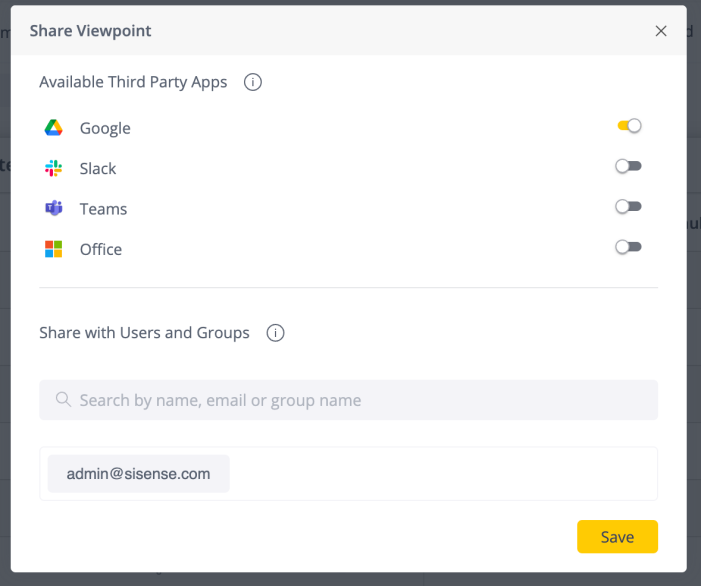
Publishing and Unpublishing a Viewpoint
Publishing a Viewpoint changes the status of the Viewpoint from Unpublished to Published. A Viewpoint cannot be published (the Publish button is disabled) until it meets the following criteria:
-
a minimum of 1 field
-
a minimum of 1 Infusion App selected
-
a minimum of 1 user or user group
To publish a Viewpoint, click Publish at the bottom of the Viewpoint Details page.

When a Viewpoint is published, it immediately appears in all Infusion Apps and to users according to existing data security and user access rules.
Unpublishing a Viewpoint will not remove the Infusion Apps, users, and user groups already selected in the Share settings.
A Viewpoint can be unpublished at any time by clicking Unpublish at the bottom of the Viewpoint Details page.
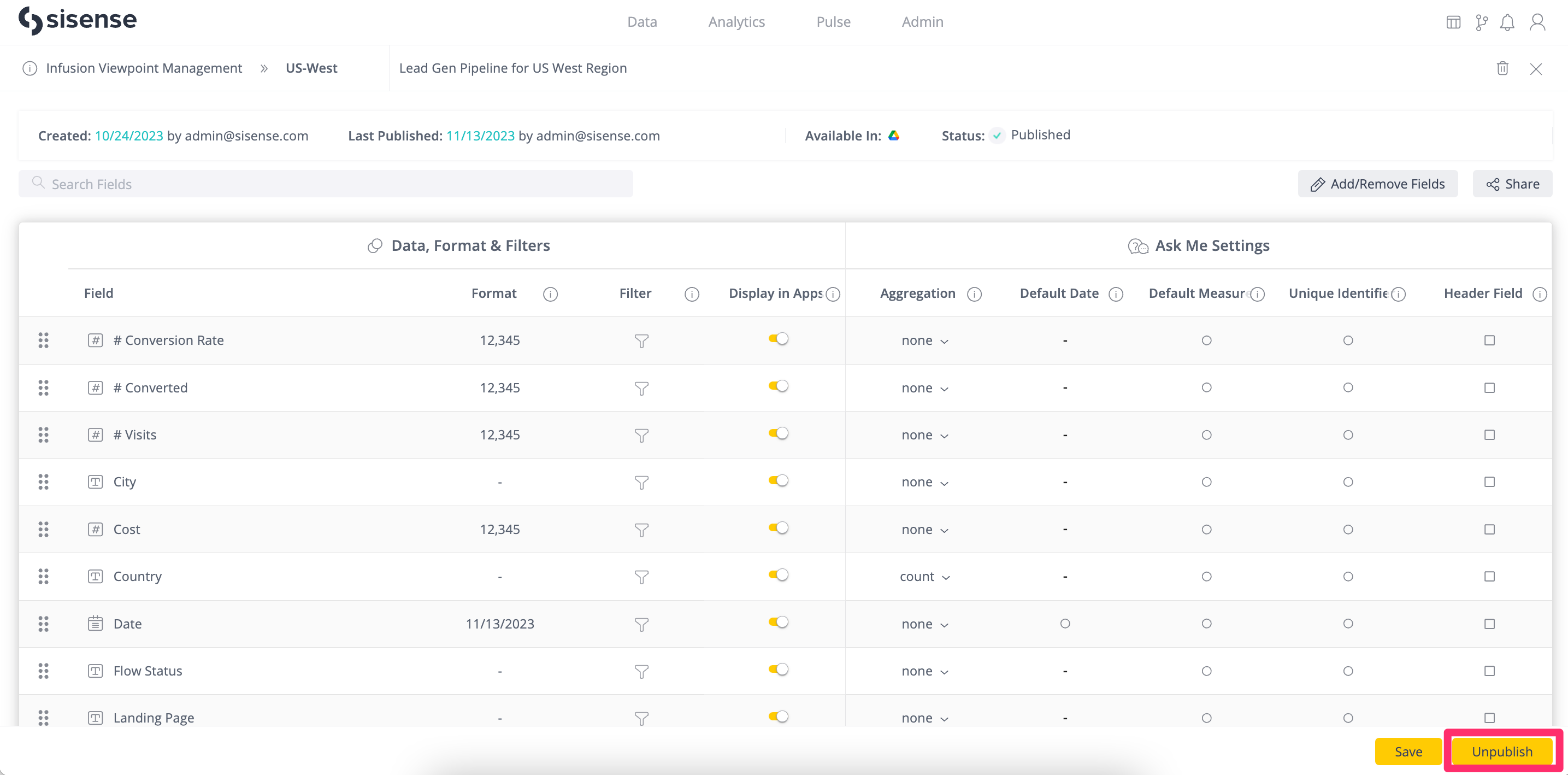
Editing a Viewpoint
Editing can be performed on an Unpublished or Published Viewpoint. Depending on the type of changes, the scale and/or impact, a Viewpoint Creator may choose to:
-
Edit an unpublished Viewpoint
-
Unpublish a Viewpoint first, and then make edits
-
Edit a published Viewpoint
The benefit to editing or modifying an unpublished Viewpoint is that the Viewpoint Creator can make changes over a period of time, without impacting Infusion Apps Users who are consuming and using the Viewpoint. To edit an unpublished Viewpoint:
-
Click the Viewpoint in the Viewpoint Management list.
-
Perform changes to the Viewpoint.
-
Click Save.
The Viewpoint must be published for changes to be visible to Infusion Apps, users, and user groups.
A Viewpoint Creator can choose to unpublish the Viewpoint prior to making changes. The benefit to this approach is the same as above. Changes can be made without impacting the Infusion Apps Users. To unpublish and edit a Viewpoint:
- Click the Viewpoint in the Viewpoint Management list.
- Click Unpublish.
- Perform the desired changes to the Viewpoint.
- Click Save.
The Viewpoint must be published for changes to be visible to Infusion Apps, users, and user groups.
Note:
When a Viewpoint is unpublished, visibility and access are immediately removed. It is recommended to communicate changes to Viewpoints prior to unpublishing.
Alternatively, a Viewpoint Creator can opt to edit a published Viewpoint. The benefit to this approach is that Infusion Apps Users receive changes immediately. To edit a published Viewpoint:
-
Click the Viewpoint in the Viewpoint Management list.
-
Perform the desired changes to the Viewpoint.
-
Click Save.
Deleting a Viewpoint
Viewpoints can be deleted from the Viewpoint Management Page or from a Viewpoint’s Details page.
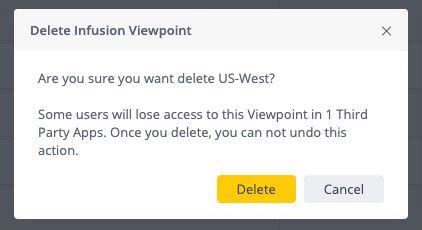
Deleted Viewpoints are immediately removed from all Infusion Apps. Users do not receive a notification that a Viewpoint has been deleted, and:
- Any charts supported by a deleted Viewpoint will break
- Any Bookmarks that reference a deleted Viewpoint will break
Note:
It is recommended to communicate changes to Viewpoints prior to deletion. Viewpoints that have been deleted are not recoverable.
Infusion Apps APIs
Sisense offers a set of REST APIs for performing CRUD functions on Viewpoints for Infusion Apps. Using these APIs can assist with managing Viewpoints at scale, orchestrating automation, and generally managing Viewpoints programmatically.